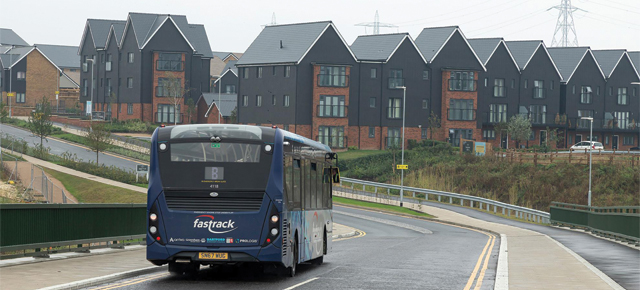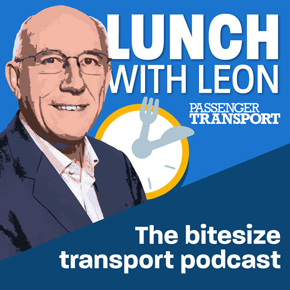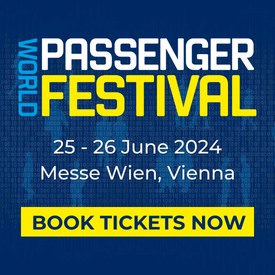Kent’s Fastrack bus-based rapid transit network is 15-years old, but its promoters are looking to the future with a switch to zero-emission

By Andrew Garnett
Kent’s Fastrack bus rapid transit scheme has been a poster child for what the bus can achieve over the last two decades.
With dedicated high-quality infrastructure backed by some serious bus priority interventions, Fastrack plays a crucial role in not only bringing the emerging Kent Thameside area together but also facilitating economic growth while also providing convenient links around Dartford, Bluewater, Ebbsfleet and Gravesend.
Many of these ideals are now enshrined in the recent bus policy announcements made by the UK Government and the devolved administrations, so it was perhaps timely for BRTuk to review the system’s progress as part of its latest series of Lunchtime Masterclasses.
Strategic importance
Daniel Gillen, principal Fastrack development planner gave a brief overview of Fastrack’s progress since the network launched in March 2006.
The first route incongruously numbered Route B, had 5km of on-street bus lanes, segregated busways and dedicated off-road busways with priority at signalled junctions. Linking Dartford and Gravesend, it was managed by Kent County Council and followed a successful funding bid from the European Community Infrastructure Fund.
Route A – again linking Dartford with Gravesend but via an extensive employment and housing development area known as The Bridge, was managed by developer ProLogis until April 2022. This was part of a 17-year contract as part of the Section 106 commitments that allowed the development next to the Dartford Crossing to proceed. “It’s an unusual deal,” said Gillen. “I’d be interested to see if any developer does something like that again.”
He added that Fastrack was very important at a strategic level and also locally and at a county level. “It’s a key part of our growth without gridlock transport plan,” Gillen said. “It’s also a key part of the implementation framework for Ebbsfleet Garden City.”
The latter has stiff targets for public transport, aiming for it to have a 40% modal share. “With Ebbsfleet being such a huge development area, it’s vital to have Fastrack as part of that,” Gillen said, adding that there were restrictions on the number of car parking spaces at the development as a planning condition.
Benefits of BRT
Gillen said Kent had chosen bus-based rapid transit as research had continually shown there were between 18% and 23% of car users who could be encouraged to switch from car to bus if buses were a quicker and more reliable option. “That’s a key focus in Kent,” he said. “We want to keep on doing more and more priority measures to really protect journey times and reliability.” He added there was also a link between the Fastrack infrastructure spend and the wider benefits for the local economy.
“BRT is not just for one particular socio-economic group either,” said Gillen. “BRT very much transcends all groups. If it’s fast enough and connects people to where they want to go, people will use it.”
He added there was evidence of people who were extremely wealthy using Fastrack as a reliable means of accessing high-speed rail services into London from Ebbsfleet International station. “It’s very much a bridging mode,” Gillen added. “It appeals to a far wider market than a regular bus.”
Gillen described the infrastructure at the heart of Fastrack as a real mixture of standard bus lanes and traffic light priority, but there are also sections of segregated busway too, primarily around The Bridge development, that offer what Gillen termed a strategic advantage for the bus.
The quicker you make journeys is what’s going to influence more people on buses
This includes a Fastrack-only bridge over the M25 that allows buses to avoid the regular congestion in the area created by problems on the Dartford Crossing. “That bridge is hugely important,” he added. “It avoids having to negotiate what is an incredibly congested junction and when the Dartford Crossing goes down it’s a huge asset for us.”
However, Gillen admitted there were issues in enforcement. While physical barriers restricted cars and other vehicles from some elements of the segregated infrastructure, it was down to the police to enforce the remainder. Changes to the 2004 Traffic Management Act should solve some of this sometimes sporadic enforcement.
Patronage building back
Covid-19 has of course had an impact on many bus networks and many are reporting patronage that is around 80% of what it was before the pandemic hit. Fastrack is bucking that trend though with patronage now in excess of what it was at the start of 2020.
“In March of this year we were at 109% of what was the 2019 monthly mean patronage,” revealed Gillen. “This is hugely encouraging. There’s a been a shift in terms of how people travel, with more leisure travel and people only travelling a couple of days each week when they would previously travel each day, but we have seen a recovery.”
He admitted there was a major reason behind this success and it was the recent opening of a large Amazon distribution hub that Fastrack serves with dedicated buses. Amazon also pays for it employees to travel for free on Fastrack.
He continued: “But that’s not the be-all and end-all; when you look at the data for Fastrack A and B from March, so the month before the A diverted to serve Amazon, and also take out all the Amazon data, we are almost 100% of where we were pre-Covid. When you add in the Amazon demand we’ve exceeded it.”
Shane Hymers, Fastrack’s development manager, added there was evidence that growth was also being achieved as a result of home working with some residents giving up their second car as Fastrack was so convenient for them. “That’s where a lot of our new numbers have come from,” he said. “The journey patterns are very different from what they were in 2019.”
Hymers added that bus patronage elsewhere in North Kent was at around 80% to 85% of what it was. “That’s still pretty good when compared to other parts of the county,” he said. “I think this is a really good demonstration of why BRT works and why journey times are so important too.”
Fastrack: next generation
The next phase of this truly ambitious BRT network will see zero-emission vehicles introduced and a new long-term contract with an operator partner.
This aims to build on the 2018 trial of an opportunity-charged electric Volvo bus which had built an appetite to move towards zero-emission operation.
“Unlike most zero-emission operations in the UK, we’re going down that opportunity charge model,” he added. “Having done extensive modelling work, that really suits the operating characteristics of the route in terms of route and the intensity of the operation.”
Gillen admitted there was a cost implication from choosing opportunity charging when compared to the more conventional pure battery-electric operation but that has been solved thanks to the award of ZEBRA funding from the UK Government. The new zero-emission fleet is expected to start entering service in 2023/2024. “We’re currently looking at what vehicles we go forward with and the charging infrastructure,” he said.
Meanwhile, the network will also expand. Following the transfer of the Route A infrastructure from ProLogis earlier this year, a dedicated Fastrack tunnel will open in late 2023/early 2024 connecting Bluewater with Ebbsfleet International and this, plus other new pieces of dedicated infrastructure. will unlock further housing developments. Elsewhere in Kent work has commenced on a new Fastrack network centred on Dover with an initial corridor linking housing developments with Dover Priory Station.
Moving to maturity
With growth now ahead of early 2020, Fastrack is looking to move to a London-style operating model with regulated headways over a conventional timetabled service. That will be supported by the new operating model. At present Arriva pays a fee for each journey to use Fastrack infrastructure. Kent County Council now plans to replace that model with a gross contract model that will see it taking the revenue risk. That could see Fastrack going cashless to speed buses up further.
“I am completely obsessed with journey times and dwell times,” added Hymers. “The quicker you make journeys is what’s going to influence more people on buses.”
LUNCHTIME MASTERCLASSES, sponsored by Atkins
May 19: Peter Shelley of Portsmouth City Council – VIEW HERE.
May 26: Angela Hosford of TfWM on Sprint – VIEW HERE.
June 9: Tony Brown of Atkins – VIEW HERE.
June 16: Liz Helen Rosenkilda Christensen on ‘Busveien’ – VIEW HERE.
June 23: Thomas Ableman, director of innovation at TfL, asks ‘Why Innovation?’ – VIEW HERE.
June 30: Shane Hymers of Kent County Council – VIEW HERE.
July 7: Robert Montgomery of Busesreinvented.com discusses ‘UK Bus: Delivering the promised land – sharing the spend and the spoils’ – VIEW HERE
ABOUT BRTuk
BRTuk has members from across the industry, including operators, promoters, manufacturers and consultants. It serves as an information hub and engages with all levels of government. Visit: www.brtuk.com
This article appears in the latest issue of Passenger Transport.
DON’T MISS OUT – GET YOUR COPY! – click here to subscribe!








